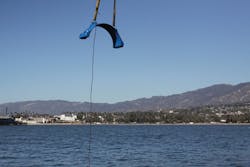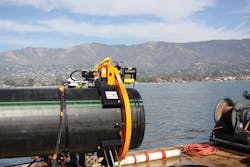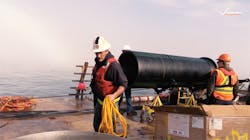In the Groove
Coupling technology proves critical to reactivation of Santa Barbara desalination plant
By Matthew Gallo
In 2015, California saw its fourth consecutive year of record-breaking drought. By autumn, the Los Angeles Times had reported that water levels at Lake Shasta were 59 percent below normal and the snowpack content of the Sierras measured only 5 percent of normal. Conditions were dire and warm weather was exacerbating drought conditions. According to California Climate Tracker, the average temperature was 3°F warmer than normal.
In January of that year, Governor Jerry Brown declared a State of Emergency in response to the drought, imposing strict water conservation measures statewide along with fines for residents who did not comply. But mandatory conservation was only part of the solution; more sources of water were needed. Later that month, the California Regional Water Quality Control Board, Central Coast Region, amended the city’s National Pollutant Discharge Elimination System (NPDES) permit to allow for reactivation of Santa Barbara’s Charles E. Meyer Desalination Facility, which had been in standby mode since 1996.
The Victaulic coupling was specifically designed to quickly join HDPE pipe and eliminate the need for fusing.
In adopting the amended NPDES permit, the Water Board classified the plant as an “existing” facility per the State Water Board’s Ocean Plan. As such, the plant would be subject to different construction requirements than those outlined for a new facility.
With firm guidelines in place, the city of Santa Barbara could begin working toward a desalination solution. In July 2015, the City Council voted unanimously to reactivate the facility.
Upgrades and Challenges
City officials understood that, after sitting idle for nearly two decades, the facility would require considerable work before it could be brought online. The first step was to inspect the facility to identify areas that needed upgrades and repairs.
One of the issues revealed by the inspection was a section of missing pipe. Eight feet of a 36-inch underwater intake line had been removed when the plant was placed in standby mode. Before the facility could be brought back online, the intake pipe needed to be repaired.
Initially, engineers thought they could solve the problem with an industry-standard joining method that would have required anchoring the coupling to the ocean floor to restrain the pulling forces created by the 80-pounds-per-square-inch (PSI) underwater pumps. Unfortunately, while technically possible, this approach would require concrete thrust blocks to be poured, adding several weeks to the already demanding schedule and, perhaps more importantly, disrupting an environmentally sensitive area. Another approach was needed to join the high-density polyethylene (HDPE) pipe end. The clock was ticking as the team had just six weeks to find a solution.
To complete the installation underwater, Victaulic repurposed its cut grooving (CG) tool so it could groove the pipe ends after being submerged.
Adapting a Proven Technology
To complete the installation underwater, it would be necessary for Victaulic to repurpose its cut grooving (CG) tool so it could groove the pipe ends after being submerged. Traditional Victaulic CG tools require electric motors to run. This posed a significant challenge considering the target was 50 feet underwater.
To cut and groove the submerged pipe ends, Victaulic retrofitted a CG3500 tool to run on a hydraulic motor located on a barge. Once the team had tested the tool to verify that it would operate properly underwater, they began making additional enhancements to protect it from the corrosive saltwater environment before commissioning it to complete the task.
The next hurdle was determining the best way to deal with strong ocean currents. Aligning the pipe ends for installation would be extremely difficult with currents pulling the pipe ends in different directions. The Style 908 coupling proved to be the best solution because of its self-aligning characteristics, which would allow a single diver to insert the two ends into the coupling, tighten the nuts until the housings were bolt pad to bolt pad, and have confidence that the coupling was properly installed.
Installation was not the only part of the project that would be affected by currents; they also posed a threat to the stability of the installed pipeline. To ensure the pipe would remain intact without the need for excessive monitoring and maintenance, Victaulic assembled the couplings using super duplex internal stiffeners in order to reinforce the pipe end.
Before beginning installation, the team had to be sure the coupling would maintain its strength and durability after being exposed to corrosive seawater for 100 years of service. To do this, engineers coated the coupling housings with fusion-bonded epoxy to eliminate the risk of corrosion and 50-pound zinc anodes were fixed to the housing bodies to provide the necessary cathodic protection.
The design of the coupling enabled underwater installation by a single diver.
Carrying Out the Installation
After several days of training and preparations aboard the barge, it was time to complete the installation. One diver accompanied the CG3500 cut grooving tool from the barge to the ocean floor. The pipe was cut and grooved successfully in 90 short minutes. The coupling was installed within 30 minutes, with a total installation time of two hours.
With pipeline integrity restored, the Charles E. Meyer Desalination Facility entered a testing phase in November 2016, and in May 2017 the facility began supplying desalinated water for the city.
By thinking outside the box and introducing modifications to proven products, engineers were able to assist the city of Santa Barbara in its efforts to address serious drought conditions. According to the city of Santa Barbara, the fully functioning desalination facility now produces nearly 3,000,000 gallons per day of potable water, meeting approximately 30 percent of the city’s demand. WW
About the Author: Matthew Gallo is a water and wastewater specialist with Victaulic. In this position, he supports the California and northern Nevada markets, providing solutions for customers to complete their jobs on time and on budget. His expertise in water systems technology and the construction industry allows him to innovate unconventional solutions to some of the most challenging projects in the business. To learn more, visit Victaulic.com.
Circle No. 259 on Reader Service Card
Desalination at Work
The newly restored Charles E. Meyer Desalination Facility draws seawater from 2,500 feet offshore, passing it through wedge wire screens at velocities of less than 0.5 feet per second (which is less than typical ocean currents) to remove sediment, bacteria, viruses, and minerals (including salt), producing ultrapure water.
The plant uses reverse osmosis to remove salt from the seawater and reintroduces natural minerals to make the water compatible with the city’s other water supplies before pumping it into the distribution system.
The waste product extracted from the process has approximately two times the salinity of seawater. It is blended with the city’s treated wastewater before being discharged into the ocean more than 1.5 miles offshore, with outflow rates controlled to protect sea life. WW




